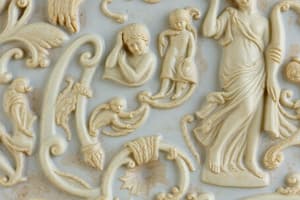Podcast
Questions and Answers
What is a ceramic?
What is a ceramic?
- A hard and heat-resistant material made by shaping and firing inorganic, nonmetallic material at high temperature (correct)
- A material made by mixing inorganic and organic materials at high temperature
- A material made by shaping and cooling metallic material at low temperature
- A soft and flexible material made by mixing organic and metallic materials at low temperature
What are some common examples of ceramics?
What are some common examples of ceramics?
- Earthenware, porcelain, and brick (correct)
- Glass, plastic, and rubber
- Concrete, wood, and fabric
- Steel, aluminum, and copper
What were the earliest ceramics made by humans?
What were the earliest ceramics made by humans?
- Glass objects made from sand and soda ash
- Pottery objects made from clay, either by itself or mixed with other materials (correct)
- Metallic objects made from iron and copper
- Plastic objects made from petroleum-based materials
What process was used to create smooth, colored surfaces on ceramics?
What process was used to create smooth, colored surfaces on ceramics?
Where does the word 'ceramic' originate from?
Where does the word 'ceramic' originate from?
Flashcards are hidden until you start studying
Study Notes
What is a Ceramic?
- A ceramic is a solid material comprising an inorganic compound, often metal oxides, silicates, or carbonates, that is created through the action of heat.
Examples of Ceramics
- Common examples of ceramics include pottery, porcelain, bricks, tiles, cement, and glass.
Early Human Ceramics
- The earliest ceramics made by humans date back to around 9000 BC, during the Neolithic period.
- These early ceramics were often simple, unglazed, and coarse in texture.
Surface Finishing
- The process of creating smooth, colored surfaces on ceramics involves applying a glaze, which is a mixture of chemicals that forms a glass-like surface when fired at high temperatures.
Etymology of 'Ceramic'
- The word 'ceramic' originates from the Greek word 'keramos', meaning 'potter's clay'.
Studying That Suits You
Use AI to generate personalized quizzes and flashcards to suit your learning preferences.




